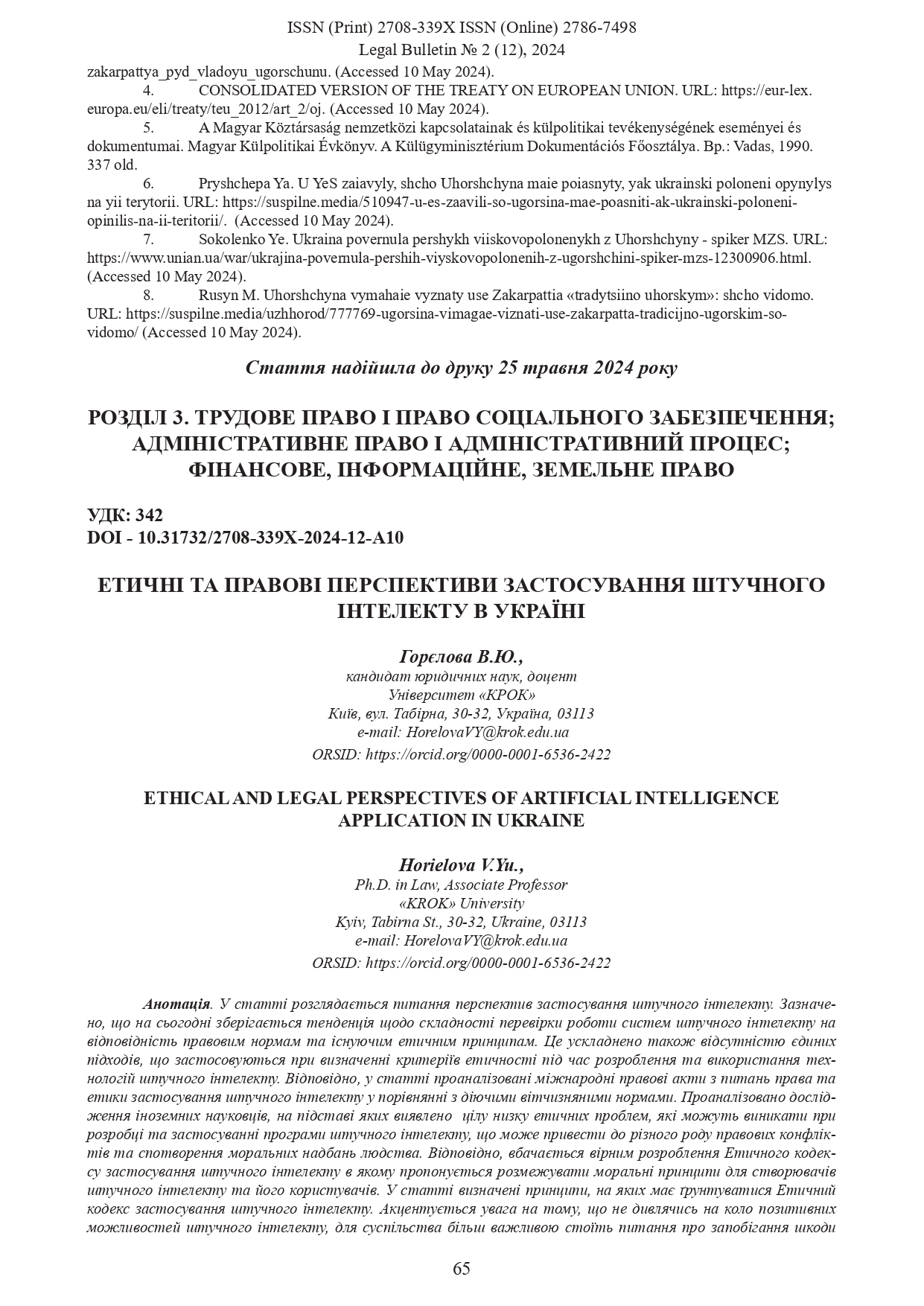ETHICAL AND LEGAL PERSPECTIVES OF ARTIFICIAL INTELLIGENCE APPLICATION IN UKRAINE
DOI:
https://doi.org/10.31732/2708-339X-2024-12-A10Keywords:
artificial intelligence, ethics, law, human rightsAbstract
The article examines the prospects for the use of artificial intelligence. It is noted that today there is a tendency towards the difficulty of checking the operation of artificial intelligence systems for compliance with legal norms and existing ethical principles. This is also complicated by the lack of uniform approaches in determining the criteria of ethics in the development and use of artificial intelligence technologies. Accordingly, the article analyzes international legal acts on the law and ethics of artificial intelligence application in comparison with current national norms. The author analyzes the research of foreign scholars, which revealed a number of ethical issues that may arise in the development and application of artificial intelligence software, potentially leading to various legal conflicts and distortion of the moral heritage of mankind. Consequently, it seems appropriate to develop an Ethical Code of Artificial Intelligence Application, which proposes distinguishing between moral principles for creators of artificial intelligence and its users. The article defines the principles on which the Ethical Code of Artificial Intelligence should be based. The author emphasizes that despite the range of positive possibilities of artificial intelligence, the issue of preventing harm to humans and their rights is more important for society. In conjunction with the development of the Ethical Code of Artificial Intelligence Application, certain legal documents should be adopted (e.g., Guidelines for the Development of Artificial Intelligence for each of the specific purposes of use, Guidelines for the Organisation and Application of Artificial Intelligence, etc.). Accordingly, the article provides some provisions on their content.
References
Horielova V. Ethical and legal principles of professional activity of a private detective on the internet. Правничий вісник Університету «КРОК». 2020. Вип. 38. С. 151-157.
European Commission for the Efficiency of Justice (2019). European Ethical Charter on the use of AI in the judicial systems and their environment. Adopted at the 31st plenary meetingof the CEPEJ (Strasbourg, 3-4 December 2018). URL: https://rm.coe.int/ethical-charter-en-forpublication-4-december-2018/16808f699c (Аccessed 13 May 2024).
CEPEJ European Ethical Charter on the use of artificial intelligence (AI) in judicial systems and their environment.(2018). URL: coe.int/en/web/cepej/cepej-european-ethical-charter-on-the-use-of-artificial-intelligence-ai-in-judicial-systems-and-their-environment (Аccessed 13 May 2024).
Концепція розвитку штучного інтелекту в Україні: Розпорядження Кабінету Міністрів України від 2 грудня 2020 р. № 1556-р 2020 URL: https://zakon.rada.gov.ua/laws/show/1556-2020-%D1%80#Text (Аccessed 13 May 2024).
White paper. On Artificial Intelligence – A European approach to excellence and trust. European Сommission. Brussels,(2020) 65 final. URL: https://ec.europa.eu/info/sites/info/files/commission-white-paperartificial-intelligence-feb2020_en.pdf (Аccessed 13 May 2024).
Cummings, J. and J. Bailenson (2016), «How much immersion is enough? A meta-analysis of the impact of immersive technologies on user presence», Media Psychology, Vol. 19.
The Guardian Rise of the racist robots – how AI is learning all our worst impulses., (2017). URL: https://www.theguardian.com/inequality/2017/aug/08/rise-of-the-racist-robots-how-ai-is-learning-all-our-worst-impulses (Аccessed 13 May 2024).
Hannah Ruschemeier. AI as a challenge for legal regulation – the scope of application of the artificial intelligence act proposal. 09 January 2023. URL: https://link.springer.com/article/10.1007/s12027-022-00725-6 (Аccessed 13 May 2024).
The EU Artificial Intelligence Act Up-to-date developments and analyses of the EU AI Act.(2024). URL: https://artificialintelligenceact.eu/ (Аccessed 13 May 2024).
Rise of the racist robots – how AI is learning all our worst impulses. The Guardian, 8 August, 2017. URL: https://www.theguardian.com/inequality/2017/aug/08/rise-of-the-racistrobots-how-ai-is-learning-all-our-worstimpulses (Аccessed 13 May 2024).
Інститут проблем штучного інтелекту. URL: http://irbis-nbuv.gov.ua/OSUA/NSOU0000131 (Аccessed 13 May 2024).
Карпенко Ю.В.(2019). Етичні принципи застосування штучного інтелекту у публічному управлінні. Вісник НАДУ. Серія «Державне управління». № 4. С. 93- 97.
Радутний О.Е. Штучний інтелект, інформаційна безпека та законотворчий процес (кримінально-правовий аспект). Інформація і право. 2018. С. 149-158.
ShiStrategies. AI – загроза або партнер людини? URL: https://strategi.com.ua/shtuchnyy-intelekt-zahroza-abo-partner-liudyny/ (Аccessed 13 May 2024).
Interfax-Україна.В ООН закликали накласти мораторій на використання технологій ШІ, які порушують права людини. URL: https://ua.interfax.com.ua/news/general/768128.htm (Аccessed 13 May 2024).
Штучний інтелект та «нова дискримінація»: як технології впливають на права та життя людини? URL: https://inspired.com.ua/creative/technology/shtuchnyj-intelekt-ta-nova-dyskryminatsiya-yak-tehnologiyi-vplyvayut-na-prava-ta-zhyttya-lyudyny/ (Аccessed 13 May 2024).
Центр демократії та верховенства права: офіц. вебсайт. URL: https://cedem.org.ua/consultations/shtuchnyi-intelekt-sud/ (Аccessed 13 May 2024).
Войнов М. Штучний інтелект та юридична сфера: чи зможуть технології замінити суддів? Центр стратегічних справ Української Гельсінської спілки з прав людини. URL: https://www.helsinki.org.ua/articles/shtuchnyy-intelekt-ta-iurydychna-sfera-chy-zmozhut-tekhnolohii-zaminyty-suddiv/ (Аccessed 13 May 2024).
EUROPEAN COMMISSION FOR THE EFFICIENCY OF JUSTICE (CEPEJ). European ethical Charter on the use of Artificial Intelligence in judicial systems and their environment. URL: https://rm.coe.int/ethical-charter-en-for-publication-4-december-2018/16808f699c (Аccessed 13 May 2024).

Downloads
Published
How to Cite
Issue
Section
License
Copyright (c) 2024 Горєлова В.Ю.

This work is licensed under a Creative Commons Attribution 4.0 International License.




